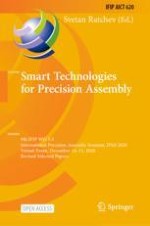1 Introduction and Motivation
2 State of the Art Safety Standards and Guidelines for Industrial Assistive Systems
-
Safety-rated monitored stop: The movements of a robot is stopped during human-machine interactions within the shared space. Such a state is safety-rated monitored with the consequence that the robot’s drives can remain energized.
-
Hand guiding: The safety is given by manual physical guiding of the robot under appropriately reduced speed.
-
Speed and separation monitoring: Movements and speed parameters are adjusted in a way to keep a safeguard space between the operator and any part of the robot.
-
Power and force limiting by design or control: Power and force control parameters are set in a way that in case of an occurring contact between a human and the robot given limits are not exceeded.
3 Safety Measures Implemented in Industrial Assistive Systems
4 Safety - State of the Art Challenges, Best Practices and Future Trends
4.1 Possibility of Modifications
4.2 Applications Are Slow and Bulky
4.3 Complex Risk Analysis
4.4 Safety Test and Verification Processes Are Not that Accurate, Reliable and High Performance
4.5 Safety Verification in Highly Dynamic, AI and Deep Learning Robotic Applications
4.6 Physical Measurement Is More Tricky Than It Seems to Be
-
As already reported the procedure defined by the DGUV have an informational and not a normative character. As long as this DGUV document is under revision for being integrated into the new ISO 10218-2 standard a SOP (standard operating procedure) has to be defined as a basis for the biofidelic measurement process, Nevertheless a clear measurement instruction document is strictly required for being certified by an accreditation body.
-
A significant challenge during the design and execution of measurements is to place and configure a measurement device as well as the robot system accurately. This includes among others the selection of a contact situation according a provided risk analysis, localization and biofidel configuration of the measurement device, ensure repeatable accuracy of robot movements and the associated reproducible measured values, documentation of measurement results as well as a comprehensive description of the robot system for which the performed evaluation is unambiguously valid, etc.An example is shown in Fig. 5 where a Franka Emika Panda robot performs a pick task of a cylindrical workpiece. Both illustrated poses of the robot enables to lower the gripper at the same constant speed to pick up the object. However, the kinematic configuration has a significant impact on the sensitivity of the robot [10]. Identical movements of the gripper leads in the elbow-up configuration (left) to a transient contact force of 318 N, whereas the elbow-down configuration (right) only 133 N have been evaluated. Also humans use this property, rising the elbow to a horizontal position if we want to press an object powerfully. The limit according to ISO/TS 15066:2016 for such a transient clamping situation of the hand (280 N) is thus fulfilled only at the elbow-down configuration. As a consequence, on the first side this example shows the possibility of inherent risk reduction by design modifications as described in Sect. 3. On the other side the tight dependency between the configuration of the robot system and the evaluated biofidel force measurement results are highlighted.
-
Having an accredidated calibration certificate for a measurement device and considering the associated uncertainty is good, but only an extremely limited way of considering uncertainty. A significantly higher impact to the total uncertainty budget is given by the integration of the measurement device into the fully specified evaluation process. Several other impact factors as environmental parameters, placement of the device, repeatability of contacts, etc. suddenly become highly relevant. Moreover, their evaluation of measurement uncertainty has to be divided into a static and dynamic load characteristic representing clamping situations and free space contacts respectively.
-
Since there is no structured comparison between inspection bodies offering biofidel measurements at the moment, it is hard to validate human skills of a measurement engineer as well as the properties of a specifically used measurement device. The research project CoHoMe, which got a cascaded funding award by the EU project COVR, focuses on closing this gap. Within the project several evaluation rounds including inter-laboratory comparison experiments at an increasing complexity, are defined. The participants of this study get immediate feedback as well as pass and fail assessment of the executed tests.
